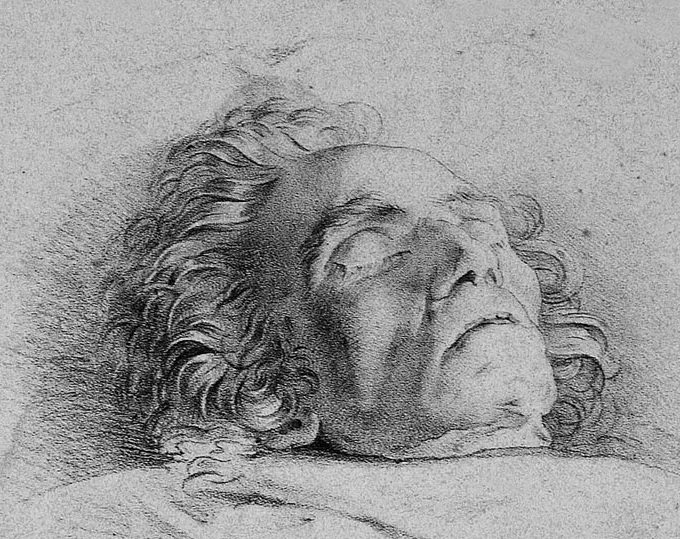Since 29 September 1826, Beethoven had been staying at his brother’s estate in Gneixendorf. Perahps that picturesque and bucolic setting had some influence on the composition of the more pastoral Opus 135 String Quartet and the replacement finale for Opus 130.
On 2 December 1826, Beethoven arrived back in Vienna. He had already been exhibiting symptoms of severe liver disease over the summer, and the cold wet two-day trip from Bneixendorf brought on an attack of pneumonia.
Soon after his arrival in Vienna in early December 1826, Beethoven wrote to Karl Holz:
I wrote to you immediately after my arrival which took place a few days ago. But the letter was mislaid. Then I fell ill, and so ill that I think it is wiser to stay in bed — Hence I shall be greatly delighted if you will visit me. … Finally, I merely add the following (Beethoven Letters No. 1541)
There follows a canon, which is commonly regarded as Beethoven’s final completed composition.

#Beethoven250 Day 365
Canon “Wir irren allesamt” (WoO 198), 1826
A studio recording of Beethoven’s creeping semitones in his last completed composition.
The author of the text of the WoO 198 canon has sometimes been cited as German physicist Georg Christoph Lichtenberg (1742 – 1799) and sometimes as composer and musical theorist Johann Phillip Kirnberger (1721 – 1783). It is neither.
Beethoven owned a collection of Kirnberger’s works, and it is possible that he encountered the text of his WoO 198 canon from this canon on page 31 of this 1773 book by Kirnberger.
However, the line originated in a polemical poem written in 1729 by Albrecht von Haller (1708 – 1777), a Swiss anatomist who dabbled in poetry. Here it is on page 66 in a book by Haller published in 1748. A prose translation of Haller’s poem under the title “An Epistle on Reason…” is available in The Poems of Baron Haller translated into English by Mrs. Howorth (London, 1794). You’ll need school or library access for Mrs. Howorth's book.
The line that Beethoven used for his WoO 198 canon appears on the bottom of page 46. Mrs. Howorth translates it as “We are all misled, but often in opposite directions.”
Soon after Beethoven’s return to Vienna in early December 1826, Dr. Andreas Wawruch was summoned to his bedside. Earlier in his life, Wawruch had planned on a career in the church but abandoned that for medicine and was now director of the General Hospital. Here are some of Wawruch's early notes about Beethoven's condition:
I found Beethoven afflicted with serious symptoms of inflammation of the lungs. His face glowed, he spat blood, his respiration threatened suffocation and a painful stitch in the side made laying on the back a torment. A severe counter-treatment for inflammation soon brought the desired relief; his constitution triumphed and by a lucky crisis he was freed from apparent mortal danger, so that on the fifth day he was able, in a sitting posture, to tell me, amid profound emotion, of the discomforts which he had suffered. On the seventh day, he felt considerably better, so that he was able to get out of bed, walk about, read and write.” (Thayer-Forbes, pp. 1017–8)
But on the eighth day I was alarmed not a little. At the morning visit I found him greatly disturbed and jaundiced all over his body. A frightful choleric attack had threatened his life in the preceding night. A violent rage, a great grief because of sustained ingratitude and undeserved humiliation, was the cause of this mighty explosion. Trembling and shivering he bent double because of the pains which raged in his liver and intestines, and his feet, thitherto moderately inflated, were tremendously swollen. From this time on dropsy developed, the segregation of urine became less, the liver showed plain indication of hard nodules, there was in increase of jaundice.” (Thayer-Forbes, pp. 1022)
Four times between 20 December 1826 and 27 February 1827, Beethoven’s abdomen was “tapped” to release fluid buildup. There were attempts to limit his alcohol intake, but they ultimately failed. One of his last letters was to Baron Pasqualati thanking him for some champagne.
On 26 March 1827, at about 5:45 in the early evening, during a thunderstorm, Beethoven died. Later accounts of his last words and actions were undoubtedly embellished. The cause of death was likely cirrhosis of the liver brought on by alcoholism.

Among the music played at Beethoven’s funeral were the 1st and 3rd of his Three Equali for Trombones (Day 256) arranged for voices, and a brass band arrangement of the Funeral March from the Opus 26 Piano Sonata (Day 138). Beethoven’s funeral included some 40 torchbearers, mostly musicians and others in Beethoven’s circle, including Carl Czerny, Karl Holz, Joseph Linke, Ignaz Schuppanzigh, and Franz Schubert, who would himself die 20 months later.